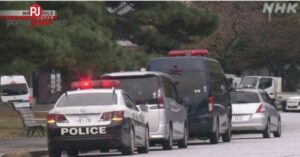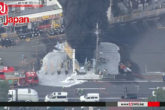Still reeling from a series of earthquakes beginning in April, Kumamoto Prefecture is once again experiencing nature’s fury, this time in the form of Mount Aso’s eruption Saturday.
Besides being on high alert for another volcanic eruption, Kumamoto residents are growing increasingly concerned about the long-term prospects for the prefecture’s tourism industry, which has yet to recover to pre-quake levels.
Saturday’s eruption occurred around 1:46 a.m. on one of the peaks of the 1,592-meter-high mountain, belching a column of ash 11,000 meters into the air, the Meteorological Agency said.

While there were no reports of injuries, it was the first explosive eruption on that particular peak since January 1980. The agency raised the alert level for the volcano to level 3 on a scale of 5 and urged people not to approach the mountain.
“If eruptions continue, tourists will inevitably decrease,” a local tourism official lamented, adding that the timing — just before the autumn tourism season begins — would severely hurt the industry.
Mount Aso and other tourist sites in the Kyushu region are popular destinations for travelers from other Asian countries.
Hotels in the Aso area were hit by at least 300 cancellations Saturday and Sunday.
Near the Hotel Sun Crown in the city of Aso, which is located about 6 km away from Mount Aso, volcanic ash lay 1 cm deep, forcing employees to scramble to clean it up. Prior to the eruption, all of its rooms had been reserved for the weekend.
“The eruption came when tourists were finally beginning to return to Kumamoto after April’s earthquakes,” said Ichiro Fujikawa, the hotel’s manager.
Elsewhere, ash also fell on the Gogaku Hotel, located some 15 km north of Mount Aso.
The hotel was scheduled to provide accommodations for 50 members of a high-school soccer team from the prefecture this weekend. But all of those reservations were canceled.
“First came an earthquake, then an eruption. Please don’t hit us anymore,” hotel employee Seiya Matsumoto said.
Shuzo Umeki, president of the company operating the hotel, voiced concern that the latest eruption may spread bad rumors that “volcanic ash is always falling in Kumamoto.”
Falling ash has been observed as far away as Takamatsu, Kagawa Prefecture, on the island of Shikoku, more than 300 km away from the eruption’s epicenter.
Also, around 27,000 residences in Kumamoto and Oita prefectures suffered a brief power outage, which was believed to have been caused by falling ash.
In Kumamoto, farmers and producers of fruits and vegetables such as strawberries and spinach expressed concern over the ash as they prepare to harvest their crops.
According to the Meteorological Agency, signs of more eruptions have not been observed, thought it urged continued vigilance.
On Sunday, a travel ban was partially lifted on a 10-km section of a road near the mountain connecting several sightseeing locations. Train service on the JR Hohi Line also resumed the same day.
Source: Japan Times Image: ANN
















Join the Conversation